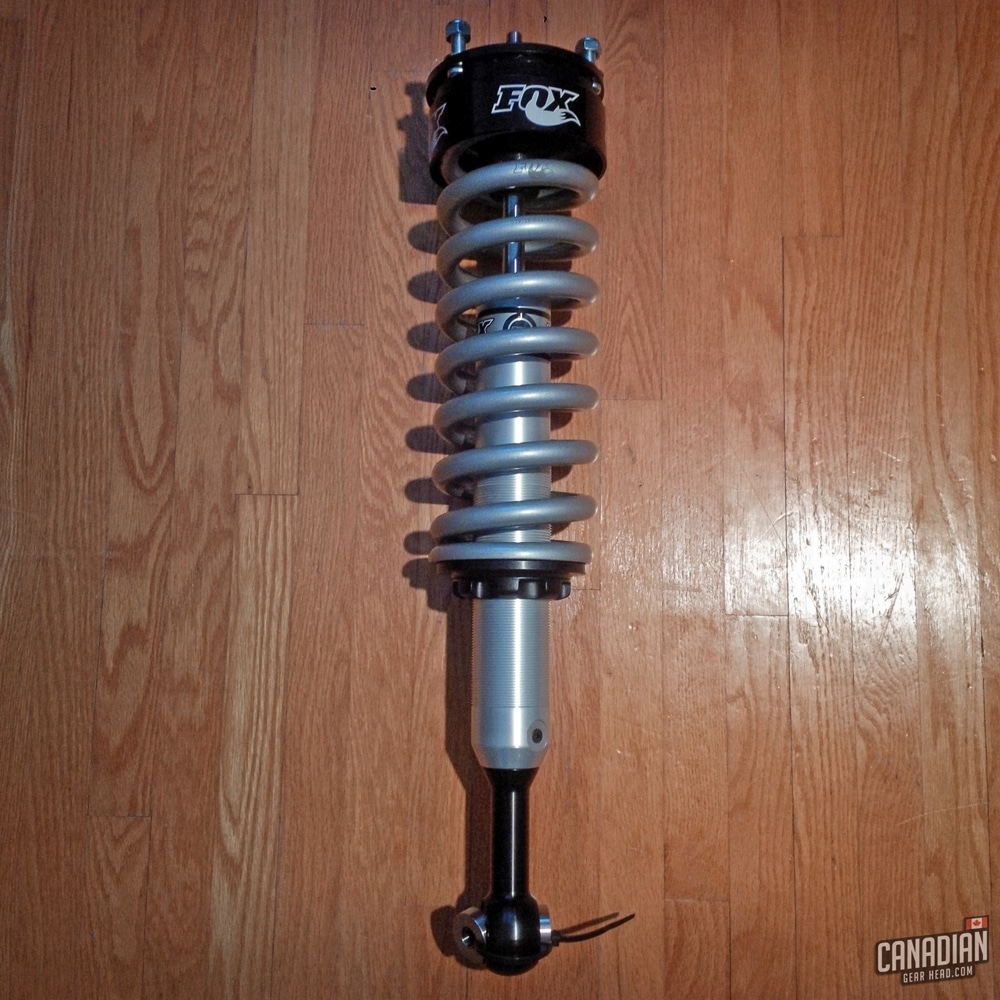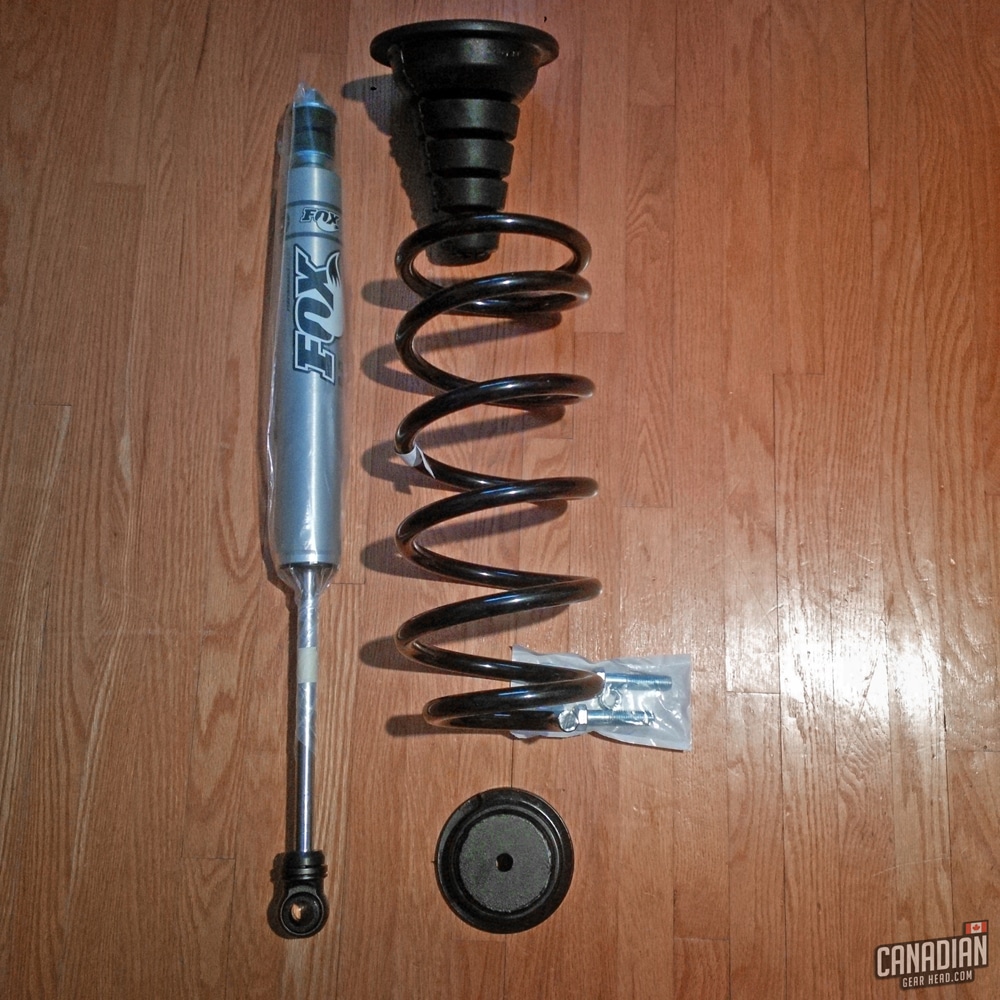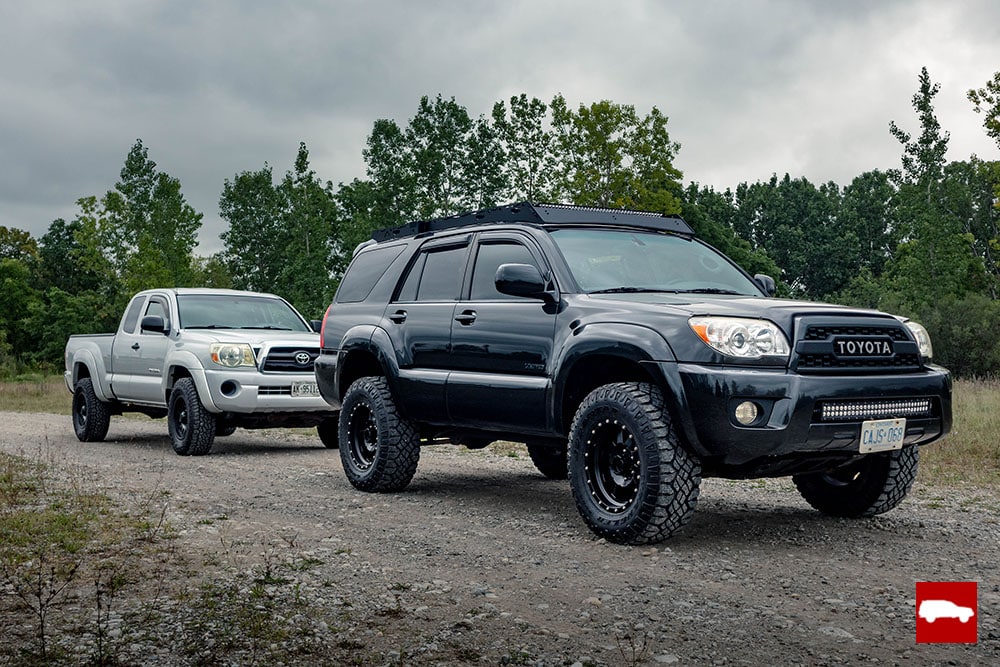More than 5 years ago, I decided to take a chance on a lesser known model of Fox suspension on my Toyota 4runner. At the time, not many people were talking about the Fox 2.0 coilovers so I gave them a shot.
After more than 50,000 km of daily driving, mountain biking, towing a trailer across Canada, and 5 salty winters, it’s time for a 2023 update on how these Fox shocks are holding up on my rig.
| Fox 2.0 PROS | Fox 2.0 CONS |
|---|---|
| High-quality finish | Ride height cannot be adjusted while installed on the truck |
| High quality finish | No rebound or compression adjustments |
| Vehicle-specific valving | Popping sound from rubber bushing would suggest a mild (and easily fixable) tolerance issue |
| Rebuildable | Excellent ride on and off-road |
| Aluminum body is good for life up north | |
| No freezing in cold temperatures (-30 degrees C) |
Fox 2.0 Coilover Overview:
The 2.0 coilover is meant to be Fox’s entry-level suspension option. Not everyone can justify spending the money for fully adjustable, large body, remote reservoir shocks. Fox’s 2.0 series seems to fit comfortably in the middle between the big boy systems and simply upgrading your shocks (while keeping your stock springs).


The pricing for these is quite good, considering what you get. They’re a few hundred more than a Toytec/Bilstein kit, and a few hundred less than any comparable option from other companies like Icon, King, or even Fox themselves.
One nice touch is that these are aluminum rather than steel. This helps them dissipate heat much better and also keeps them from rusting. That’s a really nice feature for us Canadians. I believe it’s still important to keep them clean though, as aluminum can still oxidize and corrode over time.
I purchased my Fox 2.0 suspension from 4wheelparts but they seem to be fairly easy to find online.

How Does The Fox 2.0 Compare To Other Brands?
Fox Racing is one of the leaders in off-road suspension – and not just for trucks. As a matter of fact, I’ve been running Fox suspension on my mountain bike for over a decade.
The benefits of buying entry level parts from a company as high end as Fox are clear. You’re getting their extensive off-road racing experience in a product that’s been engineered down to a lower price point.
Fox’s valving is usually very good and the 2.0 is no exception. These are actually valved specifically for your vehicle model (so you aren’t putting suspension that’s meant for the weight of a full-sized pickup on your mid-sized SUV)
| Fox 2.0 Rebuild Interval | |
|---|---|
| Street driving | 50,000 miles (80,000 km) |
| Off-road and on-road mix (50/50) | 10,000 miles (16,000 km) |
Another big plus is the fact that these are completely rebuildable. Fox recommends having them rebuilt every 50,000 miles (or 80,000 km) for street use and every 10,000 miles (or 16,000 km) for a 50/50 mix of street and off-road use. That means these could be the last shocks you ever buy for your rig!

These almost seem too good to be true, but they do have a downside – and I’d be lying to you if I said it isn’t a big issue. One of the reasons I was able to justify the extra cost of these over a set of Bilstein 5100s was the fact that they’re threaded coilovers and can be easily adjusted for height and preload.
Or so I thought.
Fox says these have “Locking, spring preload rings that allow easy ride height and preload adjustment”. That makes it sound like they can be adjusted on the vehicle at any time like any other coilover. This unfortunately is not the case at all. In order to adjust them without risking damage to the threads you must use a spring compressor to take the pressure off the collar, then make your adjustment.
That means you have to remove the coilover from the vehicle and put it in a spring compressor every time you want to adjust it. Since I don’t exactly have a full service shop with a hydraulic lift at my home, this is no simple task.
You might be able to take a lucky guess at your desired ride height and only have to do this once. But it’s more likely that you’ll want to fine-tune your adjustments meaning these will have to come off and on several times before you’re happy. I ended up leaving the factory-set ride height (a bit over 2″ of lift) as I already had them installed and the vehicle aligned.
This is a big deal to me. The comparable Bilstein 5100 is meant to be a one time, “set-it-and-forget-it” height adjustment. In my opinion, the Fox 2.0 is basically the same thing. The Bilsteins have a C-clip that holds the perch in place while the Fox’s use a threaded collar. Both the Bilstein and the Fox need to have the spring compressed off the vehicle in order to be adjusted.
After finding this out, I now realize the Bilstein and Fox 2.0 are essentially equal in terms of adjustment. Once I took them for a drive though, I quickly found out that the Fox 2.0 is far from equal in all other aspects…

Fox 2.0 Suspension Ride Quality:
Now that we have my biggest complaint out of the way, let’s talk about how these perform. In short, they’re fantastic.
It should be noted that immediately after installation we noticed a creaking/popping sound coming from the passenger side coilover when the suspension cycled. After investigating with a stethoscope, the noise was determined to be from the small rubber bushing on the shaft binding. A little penetrating oil to lube it up was all it needed, and it hasn’t made a peep ever since.
The vehicle specific valving is instantly noticeable. These just feel like they belong under the truck. I think they have the perfect combination of on-road and off-road capabilities.
After 5 years, I still feel like the ride is very smooth and controlled whether I’m flying down high speed dirt roads or heading home with a sleeping baby in the back seat. When compared back to back with my Tacoma on OEM suspension, the difference is night and day.

On-road handling:
If no one told you that the vehicle you’re driving had aftermarket suspension, you’d likely never know it. Yes, they’re that good. The level of control is much closer to a sports sedan than a lifted 4×4.
Body roll is minimal. Diving under heavy braking is very little. They have a stiffer feel than the stock suspension, but somehow they’re much more supple over rough roads. High speed stability is great. There aren’t any squeaks or rattles.
Overall, the vehicle is much more planted yet forgiving of large bumps. I don’t have any regrets about deleting the X-REAS system that came on my 4runner even though minimizing body roll is its main selling point. The Fox 2.0 does it better.

Off-road handling:
This is where the Fox 2.0 really shines. We have to manage our expectations here though. Obviously, we aren’t going to see the same results from these as shocks that cost triple the price. Compared to the stock suspension and others in the same price range though, they’re very, very good.
The ride on rough gravel roads is incredibly supple yet controlled. Large bumps are absorbed without upsetting the vehicle. I have yet to overheat them, although I haven’t run them at high speed for a prolonged period of time. These aren’t going to win the Baja 500 but driving all day without a paved road in sight won’t be a problem.
The Fox 2.0 is right at home when it comes to slow speed wheeling. They provide ample amounts of flex and make it feel like you’re riding on a cloud. You can feel the suspension articulate beneath you over large, staggered bumps but the vehicle remains level and sure-footed. These really instill confidence on the trail.
I think some people might consider these a bit too soft for more aggressive off-roading. I try to be gentle on my vehicle and stick with the mantra “go as slow as possible and as fast as necessary” so I’ve never felt like I’ve been near the limits of the Fox 2.0. With that said, I could understand if others feel like they’re in over their head when it comes to higher speeds and harsh hits.

The Verdict:
Aside from the adjustability issue, the Fox 2.0 is a great suspension system. While they aren’t exactly cheap, they still offer a ton of value. The combination of on and off-road handling is hard to beat.
I often find myself forgetting my 4runner has aftermarket suspension on it at all and that’s a good thing. You’ll be happy with these even if your rig is a pavement princess since you aren’t sacrificing any on-road behavior at all. If you do choose to head off the beaten path, they’ll have no problem handling what you throw at them.
How do I feel about the adjustment issue? Rather than spending hours removing them and paying for another alignment, I chose to leave them at the preset 2″ lift height. While the actual lift measurements are a bit more than 2″, my 4runner still has quite a bit of noticeable front end rake when paired with my OME 895 rear springs.

Everything is pretty well balanced from a functional standpoint, but I’m not happy with how it looks. Function is more important than form for me when it comes to my daily driver though, so I’m ok with it. The lower front end height helps keep the CV angles safe and allows me to avoid upgrading my upper control arms (required at around 3″ of lift).
My theory on the proper amount of lift for a vehicle is that it should be just high enough to clear your desired tire size. This is why I’m really not upset with the front adjustment since I don’t have any problems clearing 33″ tires (thanks to some strategic trimming of my front bumper).
I can’t help but think the small amount of extra stiffness in preload from raising the front end would improve the balance a bit. Some owners have reported that adjusting these to anything more than 2.5″ of lift affects the ride quality negatively so that’s something to keep in mind.
In closing, I’d highly recommend the Fox 2.0 for anyone but the most hardcore wheelers out there. If you want to hit big jumps and thrash whoop sections at 70+mph, you’ll want to upgrade, but be prepared to open your wallet!
For the rest of us average Joes, these are a fantastic upgrade over the stock suspension. I just wish it was easier to adjust the ride height without removing them. I suppose that’s the trade-off you have to make in order to avoid rusty steel bodies.

Tim is the creator of Canadian Gearhead. His experience with auto detailing and working for Toyota shows through all of the articles posted here. He runs the Canadian Gearhead site and YouTube channel full-time now and currently owns a 2007 4runner, 2006 Tacoma, and 1991 MR2. Read more about Tim:





Leave a Reply